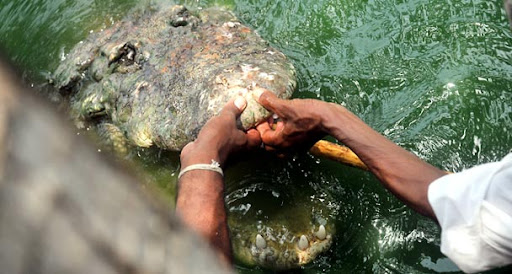
Devotees come dangerously close to the crocodiles during the four day long Sheedi Mela.-Photo by Fahim Siddiqi/ White Star.
To demonstrate this ‘fact,’ he readily jumps into the 400 feet long, 200 feet wide tank of green water filled with over a 100 cold blooded reptiles and comes out holding a three-year old baby croc to pose in front of the camera.
Even as the eight-foot long mother croc comes towards us with an angry expression, the dare devil caretaker of the shrine remains calm and freezes the intending aggressor with just a sharp nudge of his stick, which he uses like a magic wand to control the wild beasts.
Sheedi Jaat
The four day annual festival of the Sheedi community reached its climax on Wednesday at the shrine of Sakhi Sultan Baba on the outskirts of Karachi. The area where the shrine is located has come to bear the name Manghopir, which is in remembrance of the saint who was and still is popularly known as Pir Mangho by his devotees.
The festival ‘Sheedi Jaat’ is held every summer, distinct from the annual Urs of the saint, which takes place in the Islamic month of Zil Hajj.
During the festival, the Sheedi community makes offerings of fresh meat and sweets to the crocodiles. ‘We don’t offer just any meat,’ says Mohammad Hasan, a Sheedi elder. ‘We offer goat meat- and that too only from the neck.’ The tradition is centuries old, he informs, adding that the offerings are collected from every household of the community.
A procession of Sheedi women and men leave their homes at around noon each day and march towards the shrine to the sound of drumbeats. The parade is preceded by young boys holding four ‘Alams’ bearing a star symbol, which is reminiscent of the Muharram processions. But instead of the chest beating ‘Matam’ which the Shia community employs to express their mourning for the loss of Imam Hussain in Karbala, the Sheedis sing songs in Swahili to celebrate the happy occasion. The verses also contain a few phrases from the Urdu language.
On reaching the shrine, the offerings are made to the chief of the crocodiles ‘Mor Sahab’. The Gaddi Nasheen then garlands the ‘chief’ after the offering is accepted. The last ceremony takes place late in the night on the grounds of the shrine, but this time around no offering is made to the reptiles and people just sing songs to conclude the event.
Sajjad informed that because of the tense situation in the country, a large number of devotees were unable to reach the shrine this year. 'Many people come from Balochistan and interior Sindh to participate in the festival, but this time the attendance was quite low.'
Myths
There are many myths surrounding the shrine and the crocodiles that inhabit it. The Sheedis widely hold the belief that some 700 years ago, Pir Mangho was visited by the most revered saint of Sindh, Hazrat Lal Shahbaz Qalandar, who, upon seeing the barren land caused a hot water spring and date trees to erupt from the ground through a miracle of God. Legend has it that he left his lice in the pond as a gift for Pir Mangho; it is these lice which grew into the now eight foot long crocodiles.
It is because of these fantastic tales that the crocodiles of Pir Mangho are respected not only when they are alive, but also after their natural death. ‘When a crocodile dies, we give it a proper burial and wrap it in a white shroud after bathing it like we would do for a human being before putting it six feet under,’ informs Hasan.
Sheedi community
The Sheedis are Pakistanis of African origins, who are widely believed to be descendants of slaves brought years ago to the coast of Sindh and Balochistan. However, some elders of the Sheedi community say that they are actually the children of black soldiers who were part of the army of Mohammad bin Qasim, the Arab general.
There are four sub clans of the Sheedi community, including Kharadari, Laasi, Hyderabadi and Belala. Most of them reside in Sindh and Balochistan.
Crocodile worship
The custom of offering food to crocodiles at shrines is not unique to Pakistan. A similar ceremony also takes place at the shrine of Khan Jahan Ali in Bangladesh. People make offerings to reptiles in many parts of South East Asia as well to ward off evil.
There is also a tradition of worshipping crocodiles, which dates back to ancient times. In Egypt, people living by the river Nile used to worship Sobek, a god who had a human body but a crocodile head. Even today, this tradition is practiced by some tribes in parts of Africa.
No comments:
Post a Comment